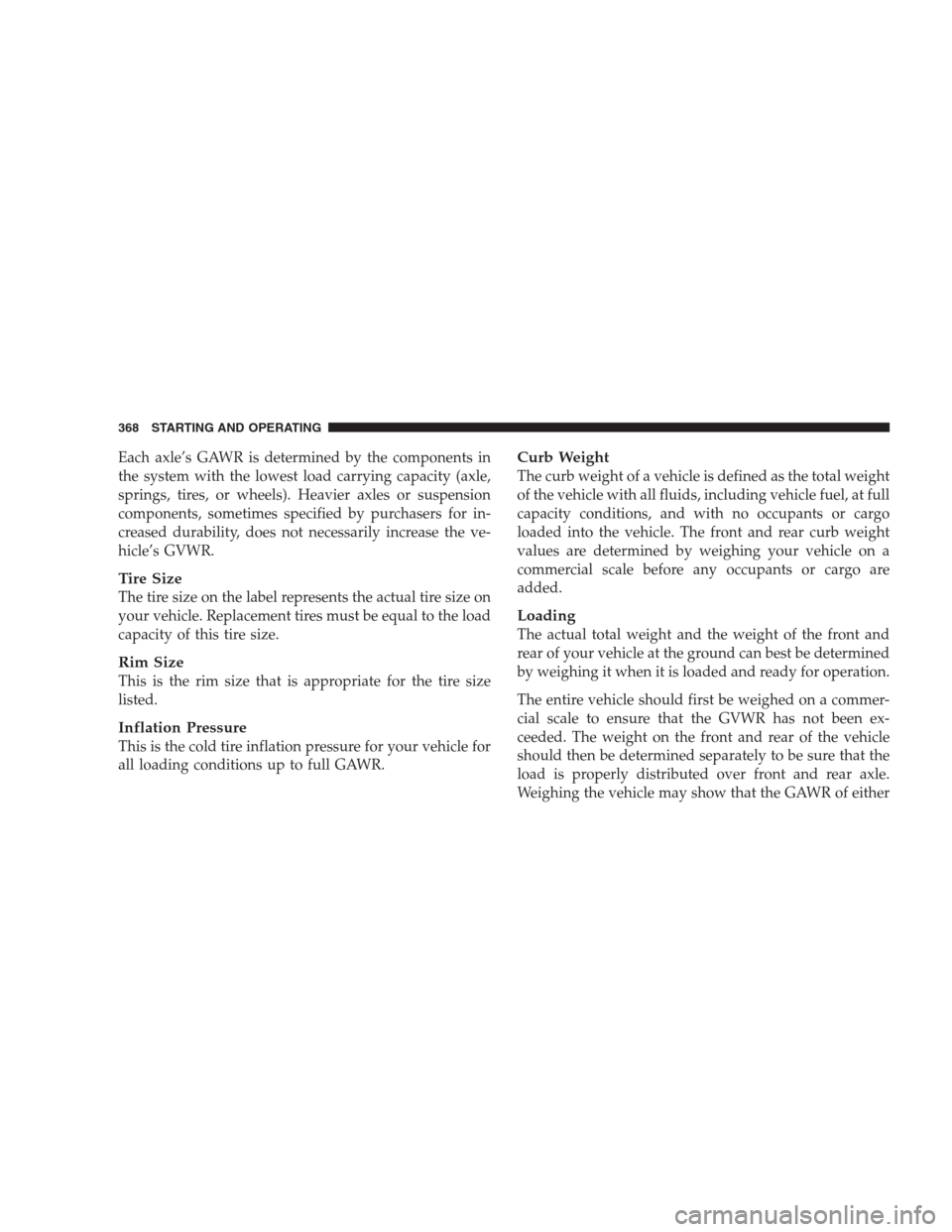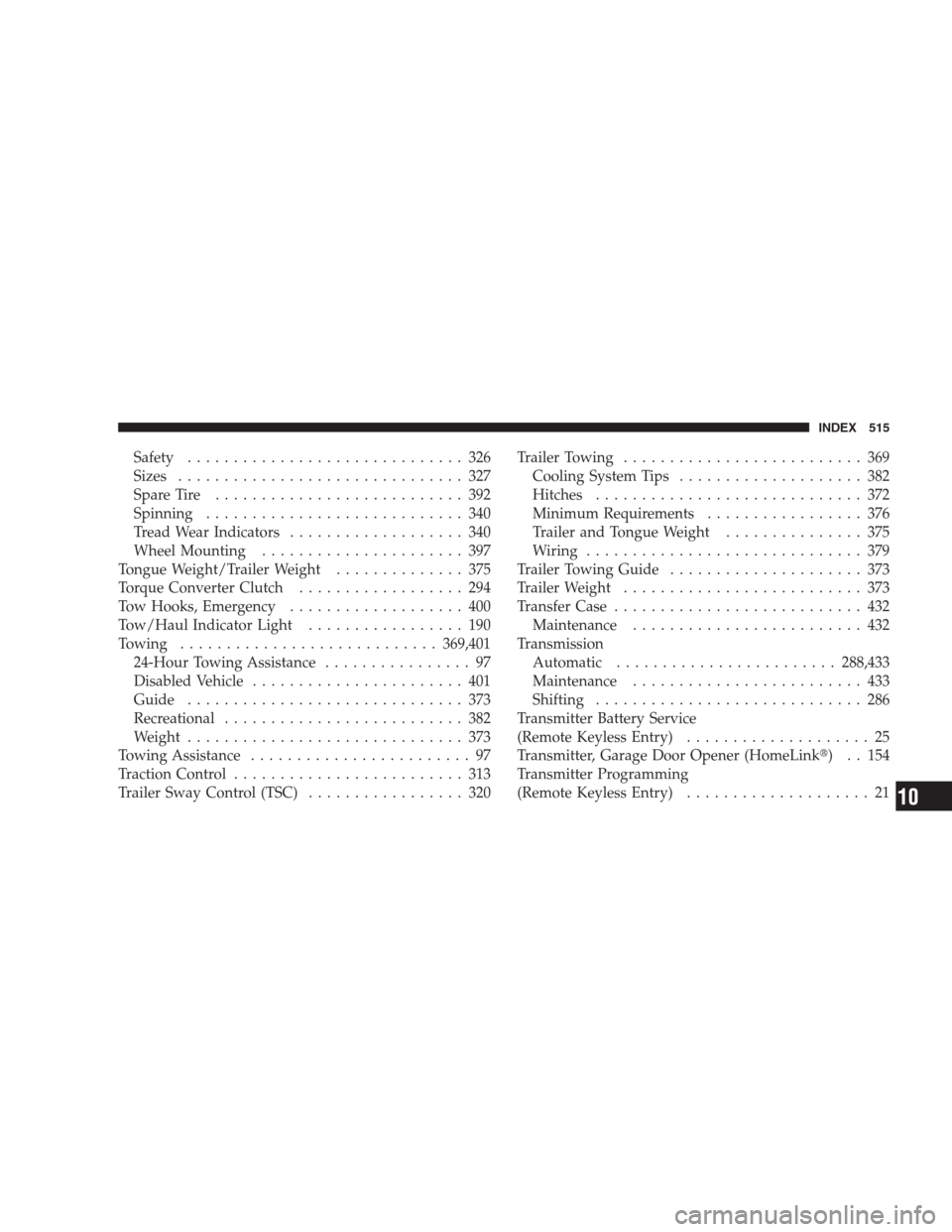Page 356 of 521

show the low tire pressure value “flashing.” Driving
the vehicle for up to 20 minutes above 15 mph
(24 km/h) will turn OFF the Tire Pressure Monitoring
Telltale Light as long as none of road tires are below
the low pressure warning threshold. The EVIC will
also display a “SPARE LOW PRESSURE” message,
and the graphic display will show a tire pressure value
in place of the “flashing” low tire pressure value.
•If your vehicle is not equipped with a matching
full-size spare wheel and tire assembly, it does not
have a tire pressure monitoring sensor in the spare tire.
The TPMS will not be able to monitor the tire pressure.
If you install the spare tire in place of a road tire that
has a pressure below the low-pressure warning limit,
upon the next ignition key cycle, the Tire Pressure
Monitoring Telltale Light will remain ON, a chime will
sound, and the EVIC will still display a “flashing”
pressure value in the graphic display. After driving the
vehicle for up to 20 minutes above 15 mph (24 km/h),the Tire Pressure Monitoring Telltale Light will flash
on and off for 75 seconds and then remain on solid. In
addition, the EVIC will display a “CHECK TPM
SYSTEM�message for three seconds and then display
dashes (- -) in place of the pressure value. For each
subsequent ignition key cycle, a chime will sound, the
Tire Pressure Monitoring Telltale Light will flash on
and off for 75 seconds and then remain on solid, and
the EVIC will display a�CHECK TPM SYSTEM�
message for three seconds and then display dashes (- -)
in place of the pressure value. Once you repair or
replace the original road tire, and reinstall it on the
vehicle in place of the spare tire, the TPMS will update
automatically.
In addition, the Tire Pressure Monitoring Telltale Light
will turn OFF and the graphic in the EVIC will display a
new pressure value instead of dashes (- -), as long as no
tire pressure is below the low-pressure warning limit in
any of the four active road tires. The vehicle may need to
354 STARTING AND OPERATING
Page 370 of 521

Each axle’s GAWR is determined by the components in
the system with the lowest load carrying capacity (axle,
springs, tires, or wheels). Heavier axles or suspension
components, sometimes specified by purchasers for in-
creased durability, does not necessarily increase the ve-
hicle’s GVWR.
Tire Size
The tire size on the label represents the actual tire size on
your vehicle. Replacement tires must be equal to the load
capacity of this tire size.
Rim Size
This is the rim size that is appropriate for the tire size
listed.
Inflation Pressure
This is the cold tire inflation pressure for your vehicle for
all loading conditions up to full GAWR.
Curb Weight
The curb weight of a vehicle is defined as the total weight
of the vehicle with all fluids, including vehicle fuel, at full
capacity conditions, and with no occupants or cargo
loaded into the vehicle. The front and rear curb weight
values are determined by weighing your vehicle on a
commercial scale before any occupants or cargo are
added.
Loading
The actual total weight and the weight of the front and
rear of your vehicle at the ground can best be determined
by weighing it when it is loaded and ready for operation.
The entire vehicle should first be weighed on a commer-
cial scale to ensure that the GVWR has not been ex-
ceeded. The weight on the front and rear of the vehicle
should then be determined separately to be sure that the
load is properly distributed over front and rear axle.
Weighing the vehicle may show that the GAWR of either
368 STARTING AND OPERATING
Page 517 of 521

Safety.............................. 326
Sizes............................... 327
Spare Tire........................... 392
Spinning............................ 340
Tread Wear Indicators................... 340
Wheel Mounting...................... 397
Tongue Weight/Trailer Weight.............. 375
Torque Converter Clutch.................. 294
Tow Hooks, Emergency................... 400
Tow/Haul Indicator Light................. 190
Towing............................369,401
24-Hour Towing Assistance................ 97
Disabled Vehicle....................... 401
Guide.............................. 373
Recreational.......................... 382
Weight.............................. 373
Towing Assistance........................ 97
Traction Control......................... 313
Trailer Sway Control (TSC)................. 320Trailer Towing.......................... 369
Cooling System Tips.................... 382
Hitches............................. 372
Minimum Requirements................. 376
Trailer and Tongue Weight............... 375
Wiring.............................. 379
Trailer Towing Guide..................... 373
Trailer Weight.......................... 373
Transfer Case........................... 432
Maintenance......................... 432
Transmission
Automatic........................288,433
Maintenance......................... 433
Shifting............................. 286
Transmitter Battery Service
(Remote Keyless Entry).................... 25
Transmitter, Garage Door Opener (HomeLink�) . . 154
Transmitter Programming
(Remote Keyless Entry).................... 21
INDEX 515
10
Page:
< prev 1-8 9-16 17-24